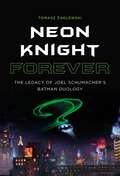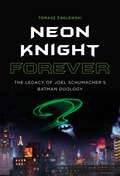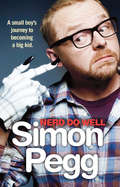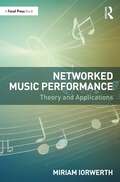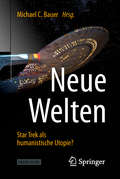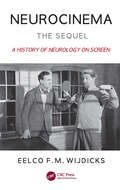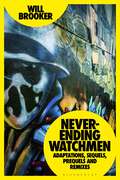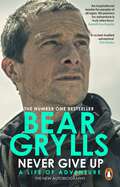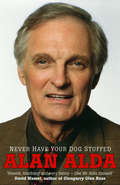- Table View
- List View
Neoliberal gothic: International gothic in the neoliberal age (International Gothic Series)
by Linnie Blake Agnieszka Soltysik MonnetA comprehensive study of how different Gothic forms have adapted, engaged with and represented the neoliberal agenda across the globe.
Neoliberalism and Global Theatres: Performance Permutations (Studies in International Performance)
by Lara D. Nielsen and Patricia YbarraHow do theatre and performance transmit and dispute ideologies of neoliberalism? The essays in this anthology examine the mechanisms and rhetorics of contemporary multinational and transnational organizations, artists, and communities that produce theatre and performance for global audiences.
Neon Knight Forever: The Legacy of Joel Schumacher’s Batman Duology
by Tomasz ZaglewskiNeon Knight Forever is a detailed study of one of the most misunderstood superhero series that dares to ask the most heretical question for all Bat-fans: what if Batman & Robin is actually a valuable achievement in big-budget superhero cinema? The Batman franchise has remained one of the most lucrative and varied lines of superhero-based titles outside its original comic book, with adaptations from filmmakers such as Christopher Nolan, Tim Burton, and Zack Snyder. However, among the many facets of Batman, there is one which remains on the margins of Bat-history, being treated as the most obscure or misconceived: the Batman duology directed by Joel Schumacher between 1995 and 1997, a creation which is seen by many fans as the "wrong" approach to the Batman mythos. Neon Knight Forever accounts for the initial rejection of Schumacher's version and explores modern attempts to rehabilitate Schumacher's vision of the infamous Neon Knight. Through discussing the formal foundations underlying both Batman Forever and Batman & Robin and featuring claims from the Schumacher online fandom, Zaglewski embraces the adaptation as a valuable addition to the Batman universe.
Neon Knight Forever: The Legacy of Joel Schumacher’s Batman Duology
by Tomasz ZaglewskiNeon Knight Forever is a detailed study of one of the most misunderstood superhero series that dares to ask the most heretical question for all Bat-fans: what if Batman & Robin is actually a valuable achievement in big-budget superhero cinema? The Batman franchise has remained one of the most lucrative and varied lines of superhero-based titles outside its original comic book, with adaptations from filmmakers such as Christopher Nolan, Tim Burton, and Zack Snyder. However, among the many facets of Batman, there is one which remains on the margins of Bat-history, being treated as the most obscure or misconceived: the Batman duology directed by Joel Schumacher between 1995 and 1997, a creation which is seen by many fans as the "wrong" approach to the Batman mythos. Neon Knight Forever accounts for the initial rejection of Schumacher's version and explores modern attempts to rehabilitate Schumacher's vision of the infamous Neon Knight. Through discussing the formal foundations underlying both Batman Forever and Batman & Robin and featuring claims from the Schumacher online fandom, Zaglewski embraces the adaptation as a valuable addition to the Batman universe.
Neorealism and the "New" Italy: Compassion in the Development of Italian Identity (Italian and Italian American Studies)
by Simonetta Milli KonewkoNeorealism and the "New" Italy centers on neorealist Italian artists' use of compassion as a vehicle to express their characters' interactions. Simonetta Milli Konewko proposes that compassion as an emotion may be activated to unify certain individuals and communities and investigates the mechanisms that allowed compassion to operate during the postwar period. Aiming to produce a deeper understanding of the ways in which Italy is re-encoded and reconstructed, this book explores the formation of Italian identity and redefines neorealism as a topic of investigation.
Nerd Do Well: A Small Boy's Journey To Becoming A Big Kid
by Simon PeggZombies in North London, death cults in the West Country, the engineering deck of the Enterprise: Simon Pegg has been ploughing some bizarre furrows in recent times. Having blasted onto the small screens with his now legendary sitcom Spaced, his rise to nation's favourite son status has been mercurial, meteoric, megatronnic, but mostly just plain great.From his childhood (and subsequently adult) obsession with Star Wars, his often passionate friendship with Nick Frost, and his forays into stand-up which began with his regular Monday morning slot in front of his 12-year-old classmates, this is a joyous tale of a homegrown superstar and a local boy made good.
Nervous Laughter: Television Situation Comedy and Liberal Democratic Ideology
by Darrell Y. HamamotoCritically analyzing four decades of television situation comedies from The Honeymooners to The Bill Cosby Show, Hamamoto shows how the sitcom reflects, explains, legitimates, and challenges the society in which it is grounded, illumining the power of laughter both to reaffirm and to question existing social structures. . . . Hamamoto offers a well-researched and refreshingly lucid study, immensely readable for its astute scholarship. Indispensable for students and scholars of television, popular culture, and comedy. ChoiceNervous Laughter examines forty years of situation comedy, decade by decade, providing the first truly panoramic view of TV's most popular dramatic form. Within this context, Hamamoto traces what he describes as the dominant liberal democratic ideology implicit within situation comedy and explains its enduring popularity. Examining liberal democratic culture, politics, and society he demonstrates how the sitcom resolves social contradictions. Borrowing freely from the social sciences, history, and literary criticism he explains the curious grip the TV sitcom has had on its audience for over forty years. This book critically assesses the relationship between the media and society bringing questions of power, equality, and democracy to the foreground. Nervous Laughter is important reading for both the specialist and the general reader in its analysis of postwar American society.Nervous Laughter is a study of liberal democratic culture, politics, and society. It describes the ways affirmative aspects and contradictions of liberal democratic ideology are given form in television situation comedy. It provides a close reading of forty years of television texts. Arguing against mainstream theories of mass communications, the author presents an analytic framework that looks instead at conflict and contradiction within class society. Challenging the legitimacy of airwave control by non-democratic social institutions, Nervous Laughter concludes with a modest agenda that might lead to democratization of television.
Netflix and the Re-invention of Television
by Mareike JennerThis book deals with the various ways Netflix reconceptualises television as part of the process of TV IV. As television continues to undergo a myriad of significant changes, Netflix has proven itself to be the dominant force in this development, simultaneously driving a number of these changes and challenging television’s existing institutional structures. This comprehensive study explores the pre-history of Netflix, the role of binge-watching in its organisation and marketing, and Netflix’s position as a transnational broadcaster. It also examines different concepts of control and the role these play in the history of ancillary technologies, from the remote control to binge-watching as Netflix’s iteration of giving control to the viewers. By focusing on Netflix’s relationship with the linear television schedule, its negotiations of quality and marketing, as well as the way Netflix integrates into national media systems, Netflix and the Re-invention of Television illuminates the importance of Netflix’s role within the processes of TV IV.
Netflix and the Re-invention of Television
by Mareike JennerThis book deals with the various ways Netflix reconceptualises television as part of the process of TV IV. As television continues to undergo a myriad of significant changes, Netflix has proven itself to be the dominant force in this development, simultaneously driving a number of these changes and challenging television’s existing institutional structures. This comprehensive study explores the pre-history of Netflix, the role of binge-watching in its organisation and marketing, and Netflix’s position as a transnational broadcaster. It also examines different concepts of control and the role these play in the history of ancillary technologies, from the remote control to binge-watching as Netflix’s iteration of giving control to the viewers. By focusing on Netflix’s relationship with the linear television schedule, its negotiations of quality and marketing, as well as the way Netflix integrates into national media systems, Netflix and the Re-invention of Television illuminates the importance of Netflix’s role within the processes of TV IV.
Netflix and the Re-invention of Television
by Mareike JennerThis book deals with the ways Netflix influenced the contemporary television landscape and built the infrastructures of streaming. It focusses on various ways Netflix reconceptualises television as part of the process of TV IV. As television continues to undergo a myriad of changes, Netflix has proven itself to be the dominant force in this development, simultaneously driving a number of these changes and challenging television’s existing institutional structures. This comprehensive study explores the pre-history of Netflix, the role of binge-watching in its organisation and marketing, and Netflix’s position as a transnational broadcaster. Netflix and the Re-invention of Television illuminates the importance of Netflix’s role within the processes of TV IV. This Second Edition highlights the role Netflix plays in the so-called streaming wars and incorporates recent research in television studies. It also re-evaluates the companies’ incorporation of issues of diversity in its focus on middlebrow television. The book also includes a new chapter on the transnational streaming franchise, networks of texts developed internal to platforms to build infrastructures of transnational streaming.
Networked Music Performance: Theory and Applications
by Miriam IorwerthNetworked Music Performance (NMP) is the essential guide to both playing music online and ensemble music through networks. Offering a range of case studies, from highly technical solutions to inclusive community projects, this book provides inspiration to musicians to try NMP whatever their level of technical expertise. Drawing upon recent research to examine the background and history of the practice as well as specific practical approaches, technical and musical considerations are included for readers, as are ideas around accessibility and creativity. Accessibility is considered in the context of the opportunities that NMP gives to musicians working remotely, as well as some of the barriers to participation in NMP and how these can be overcome. Synchronous and asynchronous approaches to NMP are explored in detail, examining the technical and musical affordances and challenges of working remotely for musicians. Networked Music Performance will appeal to music and music technology students as well as professional musicians and technicians who have started working online and wish to improve their practice. As NMP in the context of music education and community music are also explored, this book supplies educators and community leaders with knowledge and practical guidance on how to move their practice online.
Networked Music Performance: Theory and Applications
by Miriam IorwerthNetworked Music Performance (NMP) is the essential guide to both playing music online and ensemble music through networks. Offering a range of case studies, from highly technical solutions to inclusive community projects, this book provides inspiration to musicians to try NMP whatever their level of technical expertise. Drawing upon recent research to examine the background and history of the practice as well as specific practical approaches, technical and musical considerations are included for readers, as are ideas around accessibility and creativity. Accessibility is considered in the context of the opportunities that NMP gives to musicians working remotely, as well as some of the barriers to participation in NMP and how these can be overcome. Synchronous and asynchronous approaches to NMP are explored in detail, examining the technical and musical affordances and challenges of working remotely for musicians. Networked Music Performance will appeal to music and music technology students as well as professional musicians and technicians who have started working online and wish to improve their practice. As NMP in the context of music education and community music are also explored, this book supplies educators and community leaders with knowledge and practical guidance on how to move their practice online.
Neue Welten - Star Trek als humanistische Utopie?
by Michael C. BauerAm 8. September 1966 schrieb die NBC Fernsehgeschichte: An diesem Tag strahlte der US-amerikanische Fernsehsender die erste Folge einer neuen Science-Fiction-Serie aus, mit einer Geschichte über eine außerirdische Lebensform, die Salz zum Überleben braucht und aus Verzweiflung mehrere Mannschaftsmitglieder des Raumschiffes Enterprise ermordet. So recht ahnte bei NBC wohl niemand, dass in diesen 50 Minuten der Grundstein für ein ungeheuer erfolgreiches Science-Fiction-Franchise gelegt wurde: Star Trek. Allein der 50. Geburtstag von Star Trek wäre schon Grund genug gewesen, der Serie eine wissenschaftliche Tagung zu widmen. Noch dazu kommt: Ihrem Erfinder Gene Roddenberry wird nachgesagt, „seine“ Serie nach seinen eigenen humanistischen Überzeugungen geformt, im Star Trek-Universum mithin eine humanistische Utopie verwirklicht zu haben. Aber stimmt das? Ist die Zukunftsvision von Star Trek eine, in der alle humanistischen Ideale erfüllt sind? Eine Welt, in der friedliche Kooperation und die freie Entfaltung aller Individuen die (oft genug auch mörderische) Konkurrenz hinter sich gelassen haben? Diesen und vielen weiteren spannenden Fragen rund um Star Trek gingen die Gäste einer hochkarätigen, interdisziplinären Tagung vom 15. bis 17. April 2016 in Nürnberg nach. Eingeladen hatte der Humanistische Verband Bayern. Der vorliegende Band dokumentiert die Beiträge.
The Neuro-Image: A Deleuzian Film-Philosophy of Digital Screen Culture (Cultural Memory in the Present #440)
by Patricia PistersArguing that today's viewers move through a character's brain instead of looking through his or her eyes or mental landscape, this book approaches twenty-first-century globalized cinema through the concept of the "neuro-image." Pisters explains why this concept has emerged now, and she elaborates its threefold nature through research from three domains—Deleuzian (schizoanalytic) philosophy, digital networked screen culture, and neuroscientific research. These domains return in the book's tripartite structure. Part One, on the brain as "neuroscreen," suggests rich connections between film theory, mental illness, and cognitive neuroscience. Part Two explores neuro-images from a philosophical perspective, paying close attention to their ontological, epistemological, and aesthetic dimensions. Political and ethical aspects of the neuro-image are discussed in Part Three. Topics covered along the way include the omnipresence of surveillance, the blurring of the false and the real and the affective powers of the neo-baroque, and the use of neuro-images in politics, historical memory, and war.
Neurocinema—The Sequel: A History of Neurology on Screen
by Eelco F. WijdicksThe history of neurology as seen through the lens of the filmmaker is fascinating and extraordinary. Neurocinema-The Sequel is a review of the history of neurology as seen in film, starting with the early days of cinema and concluding with contemporary films now available in theaters and on streaming sites. The major themes of this book encompass how neurology has been represented in the history of cinema and how neurologic topics emerged and then disappeared, with some staging a comeback in more recent films. 180 films are assessed and rated, and many of these are exemplary depictions of neurological disorders. The author examines whether film, from a neurologic perspective, can provide insight and even debate. Each of the films discussed in this book demands serious attention by those who see and manage neurologic patients and support their families. Neurocinema - The Sequel chronicles this archive of neurologic representation, drawing readers in a rich collection of cinematic wonders of permanent cultural and historical value.
Neurocinema—The Sequel: A History of Neurology on Screen
by Eelco F. WijdicksThe history of neurology as seen through the lens of the filmmaker is fascinating and extraordinary. Neurocinema-The Sequel is a review of the history of neurology as seen in film, starting with the early days of cinema and concluding with contemporary films now available in theaters and on streaming sites. The major themes of this book encompass how neurology has been represented in the history of cinema and how neurologic topics emerged and then disappeared, with some staging a comeback in more recent films. 180 films are assessed and rated, and many of these are exemplary depictions of neurological disorders. The author examines whether film, from a neurologic perspective, can provide insight and even debate. Each of the films discussed in this book demands serious attention by those who see and manage neurologic patients and support their families. Neurocinema - The Sequel chronicles this archive of neurologic representation, drawing readers in a rich collection of cinematic wonders of permanent cultural and historical value.
The never-ending Brief Encounter
by Brian McFarlaneThis is a book for all those who have been absorbed and moved by Brief Encounter in the seventy or so years since its first appearance. It explores the central relationship of the film, where two people who fall unexpectedly in love come to realise that there is more to life than self-gratification. Mores have undoubtedly changed, for better or worse, but that essential moral choice has never lost its power. While acknowledging this, the book goes further in an effort to account for the way the film has passed into the wider culture. People born decades after its first appearance are now adept at picking up references to it, whether a black-and-white scene in a much later film or a passing joke about a bald man in a barber’s shop.
The never-ending Brief Encounter
by Brian McFarlaneThis is a book for all those who have been absorbed and moved by Brief Encounter in the seventy or so years since its first appearance. It explores the central relationship of the film, where two people who fall unexpectedly in love come to realise that there is more to life than self-gratification. Mores have undoubtedly changed, for better or worse, but that essential moral choice has never lost its power. While acknowledging this, the book goes further in an effort to account for the way the film has passed into the wider culture. People born decades after its first appearance are now adept at picking up references to it, whether a black-and-white scene in a much later film or a passing joke about a bald man in a barber’s shop.
Never-Ending Watchmen: Adaptations, Sequels, Prequels and Remixes
by Will BrookerWhat began with Alan Moore and Dave Gibbons' landmark graphic novel, Watchmen (1987) is no longer a single story, but rather a cross-platform, multi-media franchise, including a role-playing game and video game, a motion comic, a Zack Snyder movie, and a series of comic book prequels and sequels, as well as a prestige HBO TV series. Will Brooker explores the way that Watchmen expanded over time from the mid-1980s to the present day, drawing on theories of adaptation, intertextuality and deconstruction to argue that each addition subtly changes our understanding of the original. Does it matter whether these adaptations are 'faithful'? Can they ever be, as they cross over into another medium? How does each version enter a dialogue with the others? And as Damon Lindelof's series ran parallel to an entirely distinct comic book Watchmen sequel, Doomsday Clock, how do readers and viewers make sense of these conflicting narratives? Can we relate the unstable, shifting stories of Watchmen to our contemporary climate of post-truth, where we have to weigh up contradictory versions of the facts and decide which we believe?
Never-Ending Watchmen: Adaptations, Sequels, Prequels and Remixes
by Will BrookerWhat began with Alan Moore and Dave Gibbons' landmark graphic novel, Watchmen (1987) is no longer a single story, but rather a cross-platform, multi-media franchise, including a role-playing game and video game, a motion comic, a Zack Snyder movie, and a series of comic book prequels and sequels, as well as a prestige HBO TV series. Will Brooker explores the way that Watchmen expanded over time from the mid-1980s to the present day, drawing on theories of adaptation, intertextuality and deconstruction to argue that each addition subtly changes our understanding of the original. Does it matter whether these adaptations are 'faithful'? Can they ever be, as they cross over into another medium? How does each version enter a dialogue with the others? And as Damon Lindelof's series ran parallel to an entirely distinct comic book Watchmen sequel, Doomsday Clock, how do readers and viewers make sense of these conflicting narratives? Can we relate the unstable, shifting stories of Watchmen to our contemporary climate of post-truth, where we have to weigh up contradictory versions of the facts and decide which we believe?
Never Enough: My words unfiltered
by Pete Wicks'Life ain't always sunshine and flowers... I'm learning how to my own s**t and refusing to let it own me. I hope this book will help you do the same.' Behind the humour, swearing, dogs and nonsense, Never Enough is a no-holds-barred account of life through Pete Wicks' lens. He shares his mental health trials and approach to life - starting with his journey as a 16-year-old who had the words 'NEVER ENOUGH' tattooed across his body, a marker of a time of anger and sadness, but also of his struggles with self-worth. Still very much a work-in-progress, Pete reveals the lessons he has learned: the good, the bad and the ugly. He calls time on toxic positivity, the damaging impact of social media, the pressures of masculinity and our desire to remain relevant - opening up about grief, love and friendship along the way. This is Pete Wicks as you've never seen him before . . . off-camera, raw, honest, unfiltered and without the bravado.
Never Far from Dancing: Ballet artists in new roles
by Barbara NewmanA series of interviews with some of the foremost dancers in twentieth-century ballet, Never Far from Dancing reflects on the paths that their careers have taken since they retired from the stage. Barbara Newman has expertly edited each of her interviews to read as a monologue, addressing every aspect of ballet, from its styles and technical demands to its personalities, its celebrated roles and, most of all, to what happens when the dancing stops. While ballet invites all manner of writing from critics, admirers and academics, the thoughts and experiences of the dancers themselves are seldom recorded. Here, those who scaled the heights of their art hand down their wisdom and recount lives spent in this most enduring of art forms.
Never Far from Dancing: Ballet artists in new roles
by Barbara NewmanA series of interviews with some of the foremost dancers in twentieth-century ballet, Never Far from Dancing reflects on the paths that their careers have taken since they retired from the stage. Barbara Newman has expertly edited each of her interviews to read as a monologue, addressing every aspect of ballet, from its styles and technical demands to its personalities, its celebrated roles and, most of all, to what happens when the dancing stops. While ballet invites all manner of writing from critics, admirers and academics, the thoughts and experiences of the dancers themselves are seldom recorded. Here, those who scaled the heights of their art hand down their wisdom and recount lives spent in this most enduring of art forms.
Never Give Up: The extraordinary new autobiography, sequel to the global phenomenon Mud, Sweat and Tears
by Bear Grylls'A rocket-fuelled adventure.' - Tim Peake'His passion for adventure is truly infectious.' - Gareth SouthgateImprovise. Adapt. Overcome. And above all, never ever give up.In Never Give Up, global adventurer, Chief Scout and TV presenter Bear Grylls immerses readers in some truly remarkable adventures. As Bear shares personal stories from his toughest expeditions, this inspiring autobiography captures the exhilarating reality behind some of his hairiest survival missions.In this eagerly awaited follow up to his Number One bestseller Mud, Sweat and Tears, Bear takes readers behind the scenes on 'Man vs. Wild', the series that spawned an entire adventure industry. He also provides a unique and revealing insight into what it's really like to go 'Running Wild' with guests including President Obama, Roger Federer and Julia Roberts, to name but a few of his global superstar guests.Along the way, Bear opens up about his most personal challenges, discovers the true value of adventure, and embodies the enduring power of courage, kindness and a never give up spirit.THE EXTRAORDINARY NEW AUTOBIOGRAPHY FROM ADVENTURER BEAR GRYLLS.'Bear is someone who truly grabs life with both hands.' - Jonny Wilkinson'So many positive messages wrapped up in Bear's many incredible adventures.' - Roger Federer
Never Have Your Dog Stuffed: And Other Things I've Learned
by Alan AldaHe's one of America's most recognisable and acclaimed actors-a star on Broadway, an Oscar nominee for The Aviator, and the only person to ever win Emmys for acting, writing, and directing during his eleven years on M*A*S*H. Now Alan Alda has written a memoir as elegant, funny, and affecting as his greatest performances. 'My mother didn't try to stab my father until I was six,' begins Alan Alda's irresistible story. The son of a popular actor and a loving, but mentally ill mother, he spent his early childhood backstage in the erotic and comic world of burlesque and went on after early struggles to achieve extraordinary success in his profession.Yet Never Have Your Dog Stuffed is not a memoir of show business ups and downs. It is a moving and funny story of a boy growing into a man who then realizes he has only begun to grow. It is the story of turning points in his life, events that would make him what he is - if only he could survive them.From the moment as a boy when his dead dog is returned from the taxidermist's shop with a hideous expression on his face, and he learns that death can't be undone, to the decades-long effort to find compassion for the mother he lived with but never knew, to his acceptance of his father in him, personally and professionally, he learns the hard way that change, uncertainty and transformation are what life is made of, and the good life is made of welcoming them.Never Have Your Dog Stuffed, filled with curiosity about Nature, good humour and honesty, is the crowning achievement of an actor, author, and director, but surprisingly, it is the story of a life more filled with turbulence and laughter than any he's ever played on the stage or screen.


